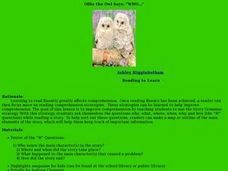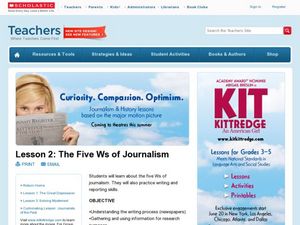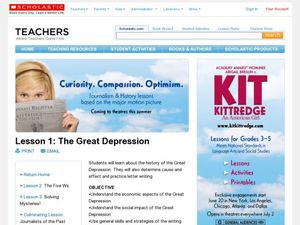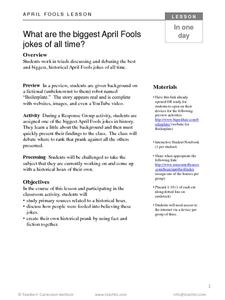Curated OER
The 5 W's
Examine how to answer who, what, when, where, and why when reading text. Young writers listen to the story Skeleton Hiccups, and as a class answer and discuss the five W's. Independently they read the story silently, and write the...
Curated OER
Ollie the Own Says: WHO
Scholars examine the strategy of making a story map or outline to identify the main elements of a story. They discuss the who, what, where, when, why, and how of a story, in an outline form. As a class they read a short story, answer the...
Curated OER
Comprehending Through Questioning
Elementary schoolers observe and apply a variety of reading comprehension strategies. They silently read a passage out of their science textbook, and discuss answering the who, what, where, when, and how of the text. In small groups they...
Curated OER
The 5 W's of Reading
Primary young scholars will use the five "W" questions for reading comprehension as they read silently to themselves so that they can understand and remember what they have read. They then read The Velveteen Rabbit aloud, discussing the...
Curated OER
Summarizing with James and the Giant Peach
Elementary readers in literature groups practice summarizing chapter-by-chapter with Roald Dahl's James and the Giant Peach. Focus on main idea, supporting details, and the 5 Ws. Unfortunately, a clever "peach" graphic organizer to which...
Curated OER
5 W Questions
Second graders practice asking the 5 W questions by reading a Boxcar Children book. In this journalism lesson, 2nd graders read a single story from the Boxcar Children series and answer the 5 W's about each specific chapter....
Curated OER
Creative Problem Solving: Using the 5 W's (Who, What, Where, When, Why)
Third graders assimilate the use of the 5 W's (Who, What, Where, When, Why) when solving problems that are presented in literature and in real life situations. They use common fairy tales to solve problems that might arise at home or...
Curated OER
The Five Ws of Journalism
Students write a mock article. In this journalism lesson, students define the word "article" and learn the five W's of article writing. Students complete a worksheet and write a paragraph using what they have learned.
Curated OER
Build Masters: Identifying Details
Find key details in books using this note card strategy. Each reader gets six cards with the classic who, what, where, when, why, and how detail prompts. After they read the book, they choose a card and locate a key detail...
Curated OER
The Great Depression: Lesson 1
Students recognize how the causes of the Great Depression affected people and their jobs. In this Great Depression instructional activity, students understand that most of the time news only came from newspapers. Students write a...
Curated OER
Build Mastery: Main Idea
Use a graphic organizer to get readers thinking about main ideas as they record the who, what, where, when, and why of a story. Consider modeling this process completely before kids do this independently. They fill in five boxes charting...
Curated OER
How can the Internet help us research the information for our news articles?
Fourth graders write a news article. In this news article lesson, 4th graders complete research and answers the five W's about their news topic. Students understand the value of interviewing for a news article. Students...
Curated OER
Who, What, When, Where, Why, and the Media
Pupils in a preschool classroom discuss potentially fearful current events in a way they can understand. They write or draw about a current event, discussing the 5 W's of news reporting.
Curated OER
WS 9.9 Presentation Questions
In this presentation worksheet, students answer questions about five different topics presented in class. These include acid rain, acid etching, pH testing, cave formation and kidney stones.
Media Smarts
Authentication Beyond the Classroom
In an age of fake news, alternative facts, and Internet trolls it is essential that 21st Century learners develop the skills they need to authenticate the facts in viral news. Here is a great way to begin with a resource that...
Curated OER
Question Words
Challenge your students to think of five question words with this brief PowerPoint. What, where, when, why, and how are all represented on their own slide with a picture and an example sentence. Tip: While presenting this slideshow, ask...
Curated OER
5 W's and H
Young scholars explore the 5W's and H of journalistic writing. In this 5 W's and H lesson plan, students read two articles from a newspaper and locate the 5 W's and H in the articles.
Curated OER
Bears' House Vandalized, Witnesses Say Blonde Girl Spotted Fleeing from the Scene
Students explore journalism. In this expository writing lesson, students read several newspaper articles and note common features. After reading Goldilocks and the Three Bears by Jan Brett, students work with a partner to write a news...
Curated OER
Bears' House Vandalized, Witnesses say Blonde Girl Spotted Fleeing from the Scene!
Students approach a familiar story (Goldilocks and the Three Bears) from the perspective of a newspaper reporter. They apply the 5 W's + 1 H (Who, What, When, Where, Why and How).
Curated OER
How the Test Was Won
Young scholars create 'Wanted' posters based around their state testing activities. In this state technology integration instructional activity, students take pictures of themselves in sepia tone in an Old West pose. Young scholars write...
Curated OER
Retelling Information
This scripted instructional activity suggests using the journalist’s five W’s (who, what, when, where, why) to teach readers how to summarize a story and to how to distinguish between significant and supporting details. A template and...
TCI
What Are the Biggest April Fools Jokes of All Time?
After working in groups to analyze primary sources related to a historical hoax, learners will discuss how people managed to be fooled and work to identify one of the biggest April Fools jokes in history.
Curated OER
Writing a Number Sentence
Third graders analyze word problems. In this number sentence lesson, 3rd graders evaluate word problems. Students create number sentences from word problems.
Curated OER
Sum It Up !!
Students practice various comprehension strategies to generate the main idea of the text. They encounter unfamiliar concepts and new vocabulary in their quest of the main idea in "Watson's Goes to Burmingham." The Five W's (What, Where,...























